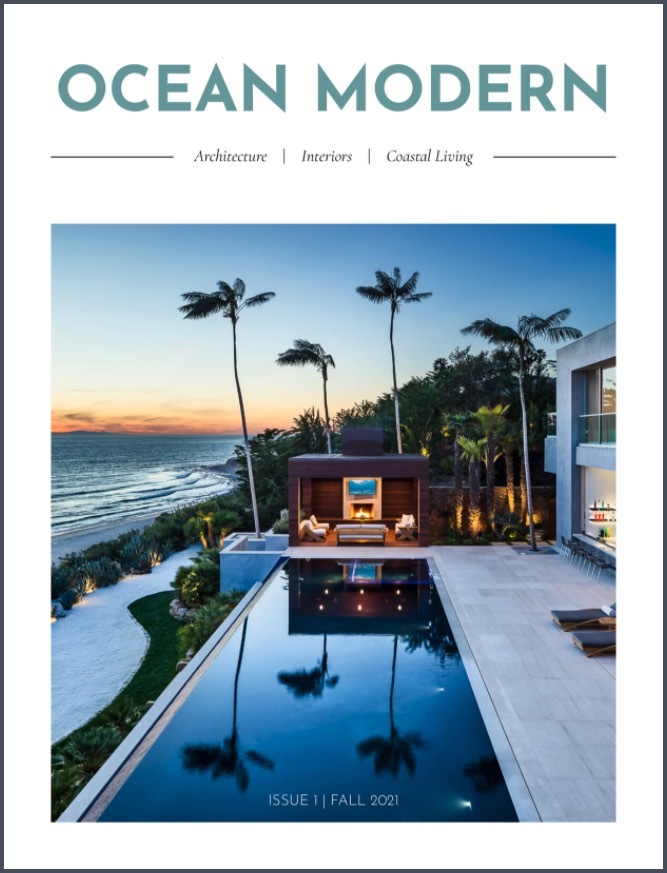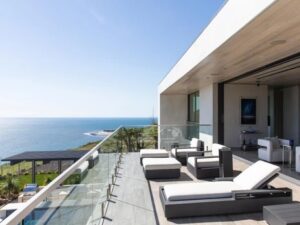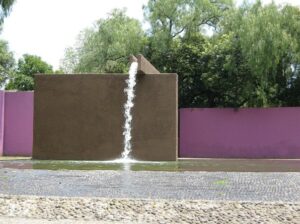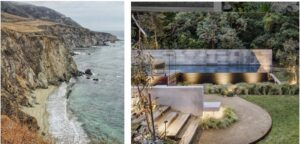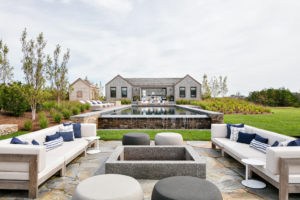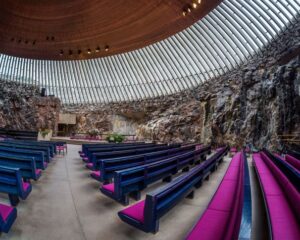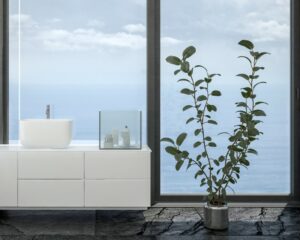An exploration into building a contemporary collection.


(Left) Image from @materialrealty on Instagram, www.instagram.com/p/CB31BdDp3kK/ and (Right) Image from @nycartistlisabeth on Instagram, www.instagram.com/p/CAw3Wr4n47F/
Southern California offers a vast number of artworks and utilitarian pieces that well represent the culture, history, and natural environment of the region, that originate from artists of past decades and movements, or contemporary artists who provide fresh, current perspectives with nods to architectural history. Assembling a collection for a California coastal home should include consideration for the following factors: the place for which you are collecting (i.e. how best to represent your house’s architecture and interior), the surrounding natural environment (for both representative purposes and climate control), the history of the area and its native artists, and your personal preferences.
In an article for Christie’s, Dina Zhang notes that “‘a well-curated art collection can reinforce the style and tone you’ve chosen for your home, whether it’s opulence, drama, or bright show-stopping colours.” With that in mind, no one should be afraid to combine works from different periods and artists within the home. The same article, which compiles the “Ten Commandments for New Contemporary Art Collectors” recommends that buyers purchase pieces they love while keeping an eye on their appreciation potential, “pay attention to provenance”, and consider works by established artists even if you think they are out of reach. Keep abreast of new movements and “trending” artists, take calculated risks, and keep an eye out for emerging talent.
According to Christie’s “Collecting Guide” for West Coast art, the California art scene has offered a wide range of artistic styles and movements since its inception, including but not limited to Conceptualism, Impressionism, Pop and Op Art, Abstractionism, and Minimalism, with many coming to prominence between the 1960s and ‘80s before becoming giants in today’s contemporary art market. While California’s contribution to the art world was not well considered until the opening of LACMA in 1965, today the state’s artists, many of whom are also activists, teachers, and philosophers, create work that is often reviewed by critics, appreciated by the public, and consistently collected.
Considering Place

(Left) Image of Santa Barbara Public Market from @littlebuns on Instagram, www.instagram.com/p/CB3aEdEhV9l/ and (Right) Image of the Malibu Beach coastline from @puppinckita on Instagram, www.instagram.com/p/B-4mSvoo9pP/
Consider purchasing pieces that not only reflect your aesthetic preferences for art, but also the personality and history of the place in which you will be displaying each piece or the collection as a whole. Consider the style of the home (Mediterranean, French country, Modern, Contemporary, etc.) and how each piece will respond to the architecture. In California, think about the state’s relationship with the Pacific (i.e. Japan), the contiguous Northwest, and with Mexico. Look into craftsmen who have contributed to California’s history and do not hesitate to include pieces by multimedia artists (architects who created pottery, painters who later sculpted, etc.) for a rounder perspective.n
Honoring California’s Contemporary Artists

(Left) A Mary Corse White Painting, Image from @dreameryuen on Instagram, www.instagram.com/p/B4xSWfphXP3/ and (Right) Abstract Composition, Green by Eric Orr, Image from LiveAuctioneers, https://www.liveauctioneers.com/item/52506121_eric-orr-american-1939-1998
Consider California artists and movements for pieces within a coastal home; the Light and Space movement boasts internationally renowned artists like Mary Corse, James Turrell, Larry Bell, Eric Orr, and more who began their journey at UCLA but eventually achieved bicoastal success. According to Artsy.net, the Light and Space Movement (or California Minimalism Movement) refers to “West Coast Minimalist art of the 1960s and 1970s that was concerned with how geometric shapes and use of light could affect the environment and perception of the viewer.” Many of these pieces also reflect light and provide atmosphere in a living space; however, some (like Corse’s pieces) are fragile and should be kept behind vitrines to avoid gathering dust or suffering from splatter.

(Left) Raymond Pettibon’s No Title (It sounds powerful…) from 2017, Image from David Zwirner, New York, Featured in “Raymond Pettibon’s Surf Paintings Express the Terror and Bliss of Being Alive” on Artsy.net, www.artsy.net/article/artsy-editorial-raymond-pettibons-surf-paintings-express-terror=-bliss-alive and (Right) Ruth Asawa’s Untitled (S.549), Image from
LiveAuctioneers, www.liveauctioneers.com/item/85883517_ruth-asawa-untitled-s549
Other contemporary artists who have continued to represent California’s exemplary art scene, either as living artists or posthumously through their body of work, include Ed Ruscha, Raymond Pettibon, Mark Grotjahn, and Ruth Asawa. Raymond Pettibon’s “Surfers” series, which the artist started in the mid 1980s while living and working in Venice Beach, California, fits the SoCal culture and landscape perfectly. Arts writer Alexxa Gotthart, in the article “Raymond Pettibon’s Surf Paintings Express the Terror and Bliss of Being Alive” for Artsy.net, notes that “his images of surfing double as glimmers of peace—even optimism—in a chaotic world” with their “little specks of humans carried by the cresting, plummeting water” and “poetic captions.”
According to Artsy.net, Ruth Asawa was “was one of California’s most renowned sculptors,” drawing influence from her time spent in Mexico, San Francisco, and the Black Mountain College in North Carolina, where she studied under and alongside Anni and Josef Albers. Her wire sculptures, one of which is pictured above on the right, were formed in response to her lessons in basket-weaving in Mexico and which, according to the artist, emerged as “three-dimensional drawings that change with the viewer’s perspective.”

(Left) Untitled (Three-tiered Perspective), 1997 by Mark Grotjahn, Colored pencil on paper, Image from Gagosian Gallery, www.gagosian.com/artists/mark-grotjahn/ and (Right) Untitled (White Butterfly) by Mark Grotjahn, 2002, Oil on Linen, from the Hill Art Foundation, Courtesy of Gagosian Gallery and the artist, www.hillartfoundation.org/art/collection/view/white-butterfly/
According to Gagosian, Mark Grotjahn’s work seeks and incorporates ideas and images from many art historical influences through combinations of “gesture and geometry with abstraction and figuration in visually dynamic paintings, sculptures, and works on paper.” Grotjahn’s most well-known series is perhaps his “Butterfly” collection, which began in 2001 and which represents the form of a butterfly in a more minimalistic depiction with monochromatic geometric forms reflected across a divide. Gagosian describes the “Butterfly” series as an exploration of the “constructs of dual and multi-point perspective” in which the subjects “take on various forms as Grotjahn alters their composition and color.”
Evoking the Natural Environment

(Left) Tony Evans 1984 Ancient Sands abstract art pottery vase, Image from www.ebay.com/itm/Tony-Evans-signed-84-ceramics-ancient-sands-abstract-art-pottery-vase-/352876973783 and (Right) Kris Marubayashi sculpture, Image from the artist’s website, www.krismarubayashi.com/page24/page24.html
For a collection that truly represents the California coastal landscape, consider works by modern and contemporary artists and artisans whose goal has been to reflect the natural world. Tony Evans, the celebrated Californian ceramicist, spent most of his life studying, working, and teaching throughout the state, at one point serving as “the inaugural chair of the Materials Department” at UCSB. His Raku pottery combines metallurgy and ceramics, most with stunning organic forms and finishes that well represent the natural environment of Coastal California with their copper and blue hues.

(Left) Double pendant chandelier by Heather Levine, Image from the artist’s website, www.heatherlevine.com/chandeliers-1 and (Right) Ceramic vessels by Sara Paloma, Image from the artist’s website, www.sarapaloma.com/portfolio/
Michelle Konstantinovsky in her article “Top 10 California Ceramicists” for California Home Design also recommends pieces by Heather Levine, Kris Marubayashi, and Sara Paloma, three currently practicing artists who create both usable and decorative works. Heather Levine fashions wall hangings from natural materials like driftwood and shells as well as utilitarian pieces like the chandelier pictured below while Kris Marubayashi’s work (pictured far above, right) includes “concrete (for its strength, unrestricted size, and flexibility), metal, and paper clay, and experimenting with different additives.”Sara Paloma notes that her pieces draw “inspiration from architecture, geology, beach combing, ancient history, industrial design, and travel” and are “a study in monumental simplicity.”
Preparing the Home

(Left) Temperature and relative humidity monitor, Image from @anastazjaharding on Instagram, www.instagram.com/p/CAZPIClp9sV/ and (Right) Image from @rfulbright.design on Instagram, www.instagram.com/p/B9Zrx5dHWo3/
Whenever new works are incorporated into an existing collection or transported to a new display area, the owner should ensure pieces are adequately protected within the home. This may include preventative measures against disasters like flooding, earthquakes, mudslides, and fires but also includes protection from everyday threats. For instance, it is vital to consider the relative humidity and temperature within the home and whether or not there is a thermostat or HVAC system by which to control it. If there is no way to control the internal environment of the home, collecting may be limited to works that can withstand a greater fluctuation in relative humidity and temperature, eschewing pieces that contain particularly responsive materials. n
Contact with direct light, either from the sun or from artificial sources within the interior of the home should also be avoided. Bulbs that emit a lot of heat and lamps that are placed too low over an object should both be avoided, as should uneven light that hits only part of an object. Also consider the safety of placement for each piece; think about how many people will be walking by, if the air condition vent it sits beneath leaks, how far it would fall if not properly attached to the wall, etc. For more information, read through the resources regarding proper RH, lux, and temperature levels provided by the Canadian Conservation Institute or use the American Institute for Conservation’s “Find a Conservator” tool to get in contact with a professional conservator nearby if needed.
Hyperlinks to External Sites:
http://www.nyehaus.com/primaryatmospheres
https://www.thesprucecrafts.com/raku-2746086
https://gagosian.com/artists/mark-grotjahn/
https://www.artsy.net/artist/mary-corse
http://www.artnet.com/artists/ruth-asawa/biography
http://www.artnet.com/artists/eric-orr/
http://www.artnet.com/artists/eric-orr/biography
https://www.artsy.net/gene/light-and-space-movement
https://gagosian.com/artists/mark-grotjahn/
https://hillartfoundation.org/art/collection/view/white-butterfly/
https://ceramics.org/memoriam/anthony-tony-g-evans
https://ceramics.org/memoriam/anthony-tony-g-evans
https://www.heatherlevine.com/shop-wallhangings/wallhanging-0347
http://www.krismarubayashi.com/page24/page24.html
https://www.californiahomedesign.com/trending/2017/05/18/top-10-california-ceramicists/
https://www.christies.com/features/A-collectors-guide-to-West-Coast-artists-8434-1.aspx
https://www.christies.com/features/10-commandments-for-new-contemporary-art-collectors-7531-1.aspx
https://www.culturalheritage.org/about-conservation/find-a-conservator
